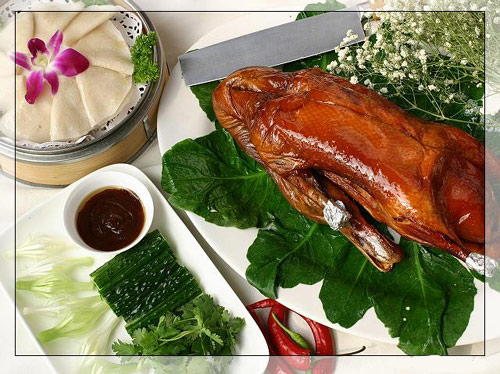People also call it the Capital City cuisine. Beijing was the capital city for the Liao, Jin, Yuan, Ming, and Qing Dynasties. Except for the Ming Dynasty (1368-1644), all the rulers of these dynasties were from northern nomadic tribes. For those 500-odd years, the dishes available from Beijing's catering trade were dominated by meat dishes, which corresponded to the eating habits of the ruling class. The Mongolian rulers of the Yuan Dynasty (1271-1368) were especially fond of mutton, and 80% of the dishes in their palace were made of mutton. These mutton dishes are still made today, such as stewed mutton, instant-boiled mutton, quick-fried mutton tripe, and fried dumplings with minced mutton.
Many of the dishes classified as "Beijing" style originated in the Imperial courts, which had at their command the best of all the food inChina.
Beijing cuisine makes liberal use of stronger flavored roots and vegetables such as peppers, garlic, ginger, leek and coriander (Chinese parsley). The most popular methods are roasting, frying, stewing, braising, and steaming. It does not emphasize strangeness or uniqueness, only delicious food made from common ingredients with tastes that are very agreeable. It is China's most typical cuisine. Because of its more northerly location, Beijing food tends to be more substantial, to keep the body warm. Instead of rice, which is the staple diet in Cantonese cuisine, more noodles, dumplings (Jiaozi), and bread (baked, steamed or fried) are served in Beijing-style restaurants. Demonstrations of the highly skilled art of turning a lump of dough into even-sized noodles can be observed in some noodle restaurants. Prime examples of Beijingcuisine areBeijing Roast DuckandShuan Yangrou(instant-boiled mutton) or "Hot Pot", which are especially popular in cold winter months of Beijing.
In ancient times, Beijing was the gathering place of the literati, businessmen and officials, and many skilled chefs followed these people to Beijing, bringing with them different cuisines, Shandong cuisine in particular, to the capital and greatly enriched the flavors of Beijing cuisine. The quick-frying techniques of Shandongcuisine and its use of onions greatly influenced Beijing cuisine. For example, quick-fried mutton, a popular and common dish, is a typical Beijing dish that uses Shandong cooking skills and flavoring methods. On the other hand, some of them wanted to eat the dishes of their native cuisines without leaving the city, which stimulated the development of other provincial cuisines in Beijing.
As an international city,Beijingalso offers many choices in western-style and non-Chinese cuisine, and the range of International cuisines here should satisfy even the most westernized of palates. Beyond this, there are plenty of fast food options, handy shopping expeditions or whenever you just need a cheeseburger. McDonald's, Kentucky Fried Chicken, Pizza Hut, Starbuck's Coffee, Subway Subs and Dunkin-Donuts have all established chain stores in the city.
Beijing Roasted Duck

Beijing Roasted Duck has the reputation of being the most delicious food in Beijing. It is usually a fixed item of dinner on any Beijingtour itinerary. Eating Beijing Roasted Duck is also one of the two things you are absolutely supposed to do while in Beijing-- the other one is climbing the Great Wall. The hometown of roasted duck is actually Nanjing City of Jiangsu Province in East China. In the 19th year (1421) during the Yongle reign of the Ming Dynasty (1368-1644), the emperor moved the capital from Nanjing to Beijing, and hence roasted duck was introduced to Beijing and became an imperial dish.
Beijing ducks are called force-fed ducks, which are raised for the sole purpose of making the food. Force-fed, they are kept in cages which restrain them from moving about, so as to fatten them up and make the meat comparably tender.
Beijing Roasted Duck has two kinds: Menlu Roasted Duck (duck roasted in the oven) and Gualu Roasted Duck (duck roasted over the hire). The preparations include: first rubbing the ducks with spices, salt and sugar, and then hanging them in the air for some time. To make a Menlu Roasted Duck, first burn the Kaoliang stalks in the oven till the sides of the oven turn hot, then put the ready-duck inside until the duck is baked date-red and shining with oil by the heat of the oven and the remaining heat of the ash. To make a Gualu Roasted Duck, the ready-duck is baked in the oven directly over the burning wood of peach, jujube or date trees, which give off a special fragrance, with very little smoke; bake until the duck becomes brown with rich grease perspiring outside and have a nice odor. The best roasted duck has a crisp skin and tender meat.
Beijing Roasted Duck is always served in well-cut slices. The chef cuts the meat into thin slices, each having a piece of skin and perfect with the complete layers of the meat. Then the meat is served with very thin pancakes, Chinese onions and special sauce -- usually sweet bean sauce. The way to eat it is to coat the thin pancake with sauce, slap on a few pieces of meat and roll up the pancake. Chopsticks are optional: it is much easier just to grab the thing with your bare hands. Normally there are many dishes served with the duck, including a dish of fine-cut shallot bars, a dish of cucumber bars and finally a dish of paste-like soy of fermented wheat flour. The dinner usually ends with a rich cream-colored duck soup made from the duck.










